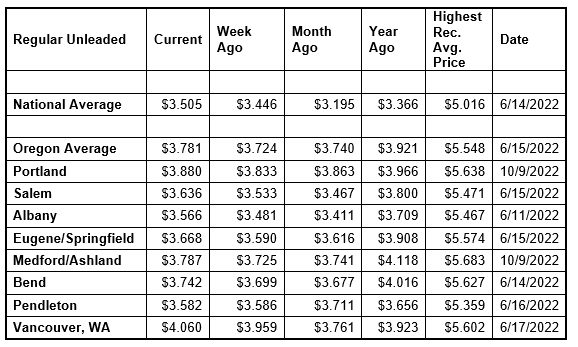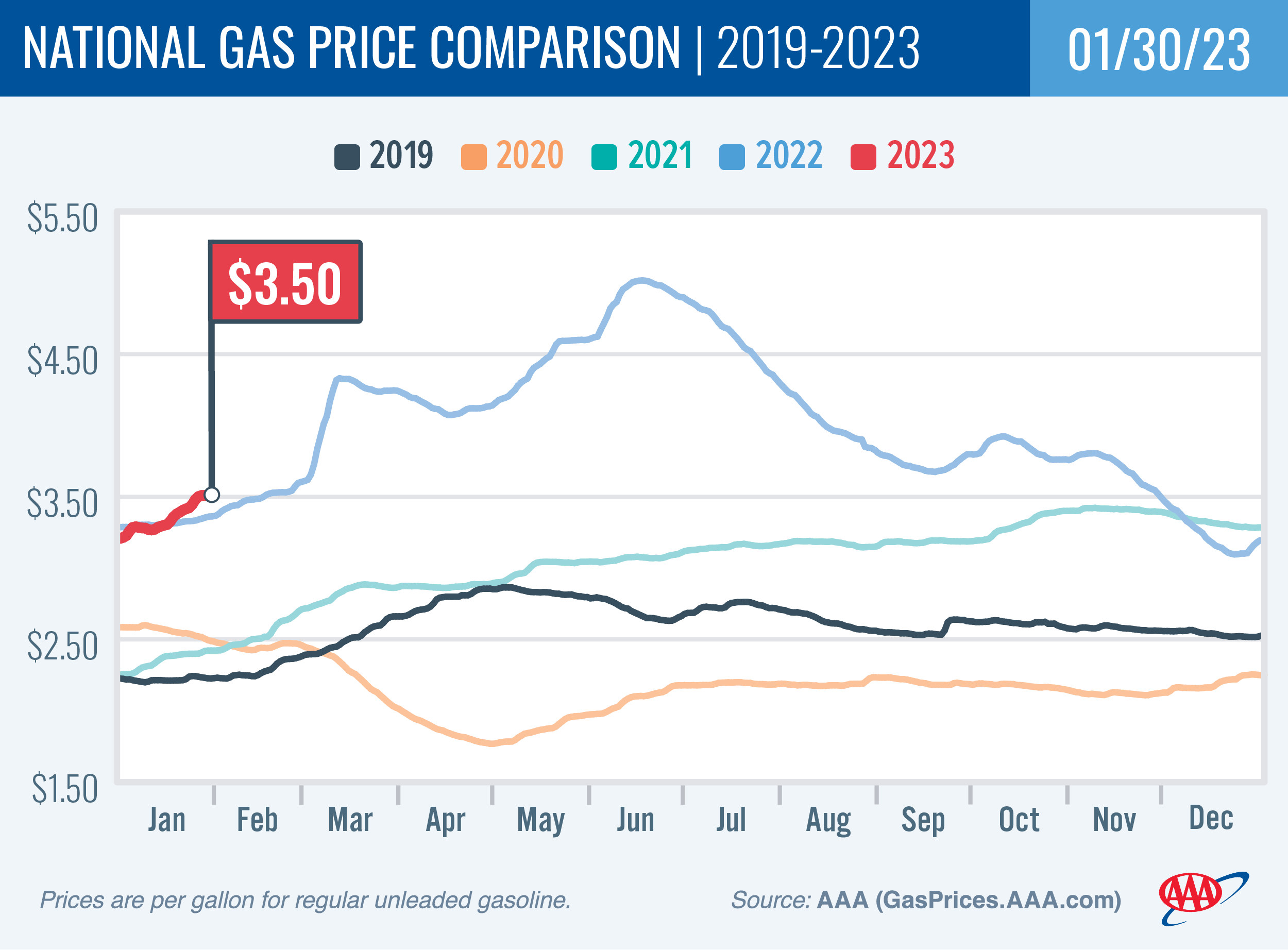PORTLAND, Ore., – The recent run of daily one-half- to four-cent increases has slowed but higher global crude oil prices and increased demand for gas in the U.S. still pushed pump prices higher. For the week, the national average for regular unleaded adds six cents to $3.51. The Oregon average also gains six cents to $3.78.

“January’s weather has been relatively mild here in Oregon and across much of the country, which led to more drivers hitting the road. However, a return of colder, wintry weather this week may mean the return to more seasonal driving patterns. This will likely lead to reduced demand for gas. But with the cost of oil remaining between about $78 and $80 per barrel, drivers probably won’t see relief at the pumps over the next couple of weeks,” says Marie Dodds, public affairs director for AAA Oregon/Idaho.
Crude oil is trading around $79 per barrel today. This month, West Texas Intermediate has ranged between about $73 and $82 bbl. and was $88 a year ago. Crude reached recent highs of $123.70 on March 8, 2022, and $122.11 per barrel on June 8, 2022. The all-time high for WTI crude oil is $147.27 in July 2008.
Crude oil prices tend to rise in response to positive economic news as countries with growing economies tend to consume more oil than countries with shrinking economies. Crude prices also increase when geo-political events have the potential to disrupt supply.
Crude prices rose dramatically leading up to and in the first few months of Russia’s invasion of Ukraine. Russia is one of the world’s top oil producers and its involvement in a war causes market volatility, and sanctions imposed on Russia by the U.S. and other western nations resulted in tighter global oil supplies. Oil supplies were already tight around the world as demand for oil increased as pandemic restrictions eased.
Crude oil is the main ingredient in gasoline and diesel, so pump prices are impacted by crude prices on the global markets. On average, about 56% of what we pay for in a gallon of gasoline is for the price of crude oil, 20% is refining, 11% distribution and marketing, and 14% are taxes, according to the U.S. Energy Information Administration.
Demand for gasoline in the U.S. rose slightly from 8.05 to 8.14 million b/d last week. This compares to 8.51 million b/d a year ago. Meanwhile, total domestic gasoline stocks increased by 1.7 million bbl to 232 million bbl. Rising gas demand and elevated oil prices have contributed to higher pump prices.
Quick stats
Oregon is one of 46 states and the District of Columbia with higher prices week-over-week. Colorado (+17 cents) has the largest weekly jump, followed by Kansas (+11 cents), and California (+11 cents). Indiana (-3 cents) and Hawaii (-1 cent) have the largest weekly declines.
Hawaii ($4.94) is the state with the most expensive gas in the nation for the 10th week in a row. California ($4.56) is second and Washington ($4.13) is third. These are the only three states with averages at or above $4 a gallon. This week 47 states and the District of Columbia have averages in the $3-range. No states have averages below $3 a gallon.
The cheapest gas in the nation is in Texas ($3.13) and Mississippi ($3.17). For the 107th week in a row, no state has an average below $2 a gallon.
The difference between the most expensive and least expensive states is $1.81 this week compared to $1.88 last week so the gap continues to shrink.
Oregon is one of 49 states and the District of Columbia with higher prices now than a month ago. The national average is 31 cents more and the Oregon average is four cents more than a month ago. Oregon has the third-smallest monthly increase in the nation. Colorado (+97 cents) and Georgia (+63 cents) have the largest monthly gains. Hawaii (-9 cents) is the only state with a monthly decline.
Oregon is one of only six states with lower prices now than a year ago. The national average is 14 cents more and the Oregon average is 14 cents less than a year ago. This is the fourth-largest yearly drop in the nation. Connecticut (-15 cents) has the largest year-over-year decline. Colorado (+56 cents) and Hawaii (+55 cents) have the biggest year-over-year jumps.
West Coast
The West Coast region continues to have the most expensive pump prices in the nation with six of the seven states in the top 10. This is typical for the West Coast as this region tends to consistently have fairly tight supplies, consuming about as much gasoline as is produced. In addition, this region is located relatively far from parts of the country where oil drilling, production and refining occurs, so transportation costs are higher. And environmental programs in this region add to the cost of production, storage and distribution.
| Rank | Region | Price on 1/31/23 | ||
| 1 | Hawaii | $4.94 | ||
| 2 | California | $4.56 | ||
| 3 | Washington | $4.13 | ||
| 4 | Nevada | $3.99 | ||
| 5 | Colorado | $3.86 | ||
| 6 | Pennsylvania | $3.79 | ||
| 7 | Oregon | $3.78 | ||
| 8 | Alaska | $3.76 | ||
| 9 | Illinois | $3.68 | ||
| 10 | District of Columbia | $3.63 |
As mentioned above, Hawaii is the most expensive state in the nation, with California, Washington, Nevada, Colorado, Pennsylvania, Oregon, and Alaska rounding out the top eight. Arizona is 13th. Oregon slips to seventh after three weeks at sixth.
Six of the seven states in the West Coast region are seeing week-over-week increases. California (+11 cents) has the largest jump in the region while Alaska (+1 cent) has the smallest. Hawaii (-1 cent) is the only state in the region with a weekly decline.
The refinery utilization rate on the West Coast fell from 80.3% to 79.2% for the week ending January 20. This rate has ranged between about 76% to 92% in the last year.
According to EIA’s latest weekly report, total gas stocks in the region decreased from 34.39 million bbl. to 34.04 million bbl.
Oil market dynamics
Although a higher dollar contributed to pushing crude oil prices lower at the end of last week, oil prices rose earlier in the week amid ongoing market optimism that global oil demand will be more robust than anticipated in 2023 due to China re-opening its economy after imposing strict COVID-19 lockdowns that curtailed demand. For this week, crude prices could increase again if the market sees more indications that inflation may be cooling, which could keep oil demand robust despite ongoing concerns that a recession may occur this year.
At the close of Friday’s formal trading session, WTI decreased by $1.33 to settle at $79.68. At the close of Monday’s formal trading session, WTI fell $1.78 to close at $77.90. Today crude is trading around $79, compared to $80 a week ago. Crude prices are about $9 less than a year ago.
Drivers can find current gas prices along their route with the free AAA Mobile app for iPhone, iPad and Android. The app can also be used to map a route, find discounts, book a hotel and access AAA roadside assistance. Learn more at AAA.com/mobile.

Diesel
For the week, the national average adds four cents to $4.68 a gallon. The record high is $5.816 set on June 19, 2022. The Oregon average rises six cents to $4.79. The record high is $6.47 set on July 3, 2022. A year ago the national average for diesel was $3.72 and the Oregon average was $4.12.
Find current fuel prices at GasPrices.AAA.com.
AAA news releases, high resolution images, broadcast-quality video, fact sheets and podcasts are available on the AAA NewsRoom at NewsRoom.AAA.com.
Find local news releases at https://oregon.aaa.com/community/media/media-contacts.html

